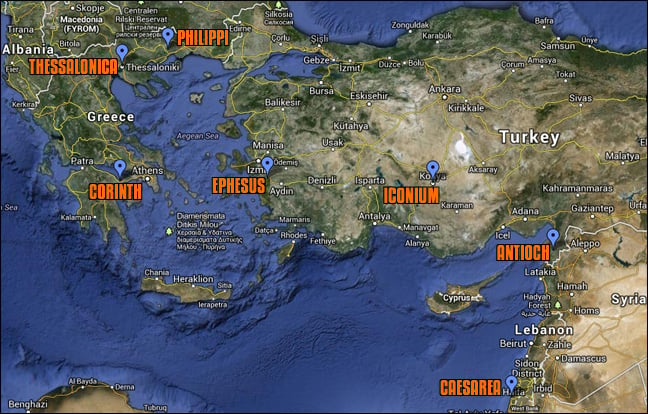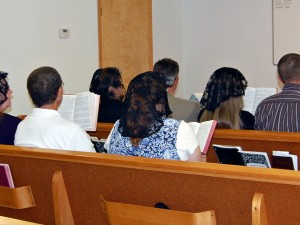Why Head Coverings? Reason #4: Church Practice

“Paul taught all the churches this custom and he expected them to follow it. In this final statement he cuts off all further argument by appealing to universal Christian usage.” – Mary A. Kassian (Professor of Womens Studies, SBTS) 1) Mary Kassian – Women, Creation and the Fall (Crossway Books, 1990) – Page 100.
When we hear the word “tradition” we usually think of it as the inventions of man which are not found in Scripture. The traditions may be beneficial (or at least not harmful) but because God doesn’t command them, neither should we. When it comes to understanding head coverings we need to ask, is this a tradition or a command? Let’s look at our first verse:
Now I praise you because you remember me in everything and hold firmly to the traditions, just as I delivered them to you. (1 Cor 11:2 NASB)
Though the “traditions” are not defined, it is very likely that head covering was one of them. Why do I think this? The teaching on head coverings (1 Cor 11:3-16) is sandwiched in between two contrasting statements. In verse 2 Paul says “I praise you” followed by teaching on head coverings. Then in verse 17 he says “I do not praise you” followed by teaching on the Lord’s supper and spiritual gifts (which they were misusing). The sentence structure of 1 Corinthians 11 uses verses 2 and 17 as topic headings. What immediately follows each of those verses is a teaching on the practices that fit the heading; the first to inform (praise) and the latter to correct (praise not). If head coverings were not being practiced by the Corinthians, it likely would have been addressed under “I do not praise you” (1 Cor 11:17).
So if the Corinthians were in fact covering (although still needing teaching as to its purpose) then that makes it a tradition since that’s what Paul called it. Now before you dismiss covering as an invention of man, let’s let the New Testament give us our definition of tradition. The Greek word used is “paradosis” which is used in the New Testament 13 times. It’s used 8 times by Jesus and every time He says it, it is clearly in reference to the “traditions of men”. Paul also uses the term in this way but not exclusively. Sometimes he uses it in reference to authoritative apostolic teaching. Let’s look at two instances where he does that:
So then, brethren, stand firm and hold to the traditions which you were taught, whether by word of mouth or by letter from us. (2 Thess 2:15 NASB)
Now we command you, brethren, in the name of our Lord Jesus Christ, that you keep away from every brother who leads an unruly life and not according to the tradition which you received from us. (2 Thess 3:6 NASB)
Did you catch the pattern? When Paul uses paradosis to refer to apostolic teaching he says it came “from us”.
So how do we know if head covering is the tradition of men or of the apostles? Paul doesn’t leave us guessing. In 1 Cor 11:2 he said, “I delivered [the traditions] to you”. This means that head covering is authoritative apostolic teaching.
The Church’s exclusive position
Let’s now take a look of the last verse concerning head covering:
If anyone is inclined to be contentious, we have no such practice, nor do the churches of God. (1 Cor 11:16 ESV)
We just established that head covering is authoritative apostolic teaching, so what’s happening here? This verse was what kept me from embracing head coverings for years. Here’s how I used to see it: what Paul is saying is this doctrine can be very contentious. He doesn’t want that, so if you feel upset just don’t practice it. Besides, none of the churches make it mandatory anyway.
Is this a contradiction? Did the churches have an official stance on head covering or not? Greek scholar, Daniel Wallace offers some help:
How do we reconcile 1 Cor 11:2 with 1 Cor 11:16? Verse 2 governs v 16. That is to say, because the practice was a paradovsi, it was put on the level of orthopraxy. It was a doctrine that the early church followed. Since it was on this level, most of the churches followed it religiously. Hence, Paul could appeal to what other churches were doing (v 16) as an appeal to the reasonableness and pragmatic outworking of this ‘tradition.’ 2) From ‘What is the Head Covering in 1 Cor 11:2-16 and Does it Apply to Us Today?’. Daniel Wallace holds the ‘meaningful symbol‘ view of head coverings, not the position I’m advocating for.
So Paul is saying that if someone is being contentious, the churches have “no such practice” as the one that the contentious person is advocating for. Not that there is no official position on head covering, he just finished giving that defense. Rather, there is no church that holds to the view that this contentious person is promoting. That’s why other versions translate this text as, “we have no other practice, nor have the churches of God” (1 Cor 11:16 NASB).
Beyond Corinth
Some argue that Paul commanded women to practice head coverings because if they didn’t they may be identified with the temple prostitutes in Corinth who didn’t wear one. However, in 1 Cor 11:16 Paul shows that this goes beyond Corinth and is the practice of all churches, everywhere. Just think geographically of the churches that were in existence at this time: Corinth, Phillipi, Thessalonica, Ephesus, Iconium, Caesarea, Antioch and many more. They all practiced head coverings. All these churches have a mixture of Jews and Gentiles fellowshipping in them and are from different cultures. They are spread out geographically over thousands of miles over such places as modern day Israel, Turkey & Greece. Yet, they all hold to the same Christian doctrine regarding head coverings. How can such unity be accounted for except the church understanding head coverings as a command for all Christians?

The Church in Corinth: 150 years later
Tertullian was a Christian apologist who lived from 160-220AD. One of the books he wrote was called “The Veiling of Virgins” in which he argued from Scripture and tradition (of men) that all women are to be covered, not just those that are married. There’s one very helpful statement that he said about the church in Corinth in his day, approximately 150 years after Paul wrote his first letter to them. Let’s take a look at it.
“So, too, did the Corinthians themselves understand him. In fact, at this day the Corinthians do veil their virgins. What the apostles taught, their disciples approve.” 3) Tertullian – On The Veiling Of Virgins – Chapter VIII.
Having observed the 3rd century Corinthian church first hand, Tertullian in essence says “they understood that Paul meant all women must wear head coverings. That’s evidenced by the fact that to this day that is still their practice.”
This teaching remained the standard practice of most churches throughout the majority of Church History. As R.C. Sproul notes “The wearing of fabric head coverings in worship was universally the practice of Christian women until the twentieth century. What happened? Did we suddenly find some biblical truth to which the saints for thousands of years were blind? Or were our biblical views of women gradually eroded by the modern feminist movement that has infiltrated the Church of Jesus Christ which is “the pillar and ground of the truth”? 4) I haven’t been able to track down the original source of this statement. It is a heavily quoted statement and one such quotation appear’s in Greg Price’s article ‘Head Coverings in Scripture’.
Head coverings are not some new strange doctrine. This is an old doctrine, based in the Bible and understood that way by the majority throughout the history of the church. Head coverings were practiced in all churches and we are the exception today. It’s time to change that.
References
- The Head Covering Movement’s New Direction: A Call for Team Members - July 11, 2025
- Is Head Covering Related to Spiritual Gifts? A Response to Barry York - July 5, 2023
- A Husband’s Authority is Limited (He is Not Pastor or King) - November 14, 2022



